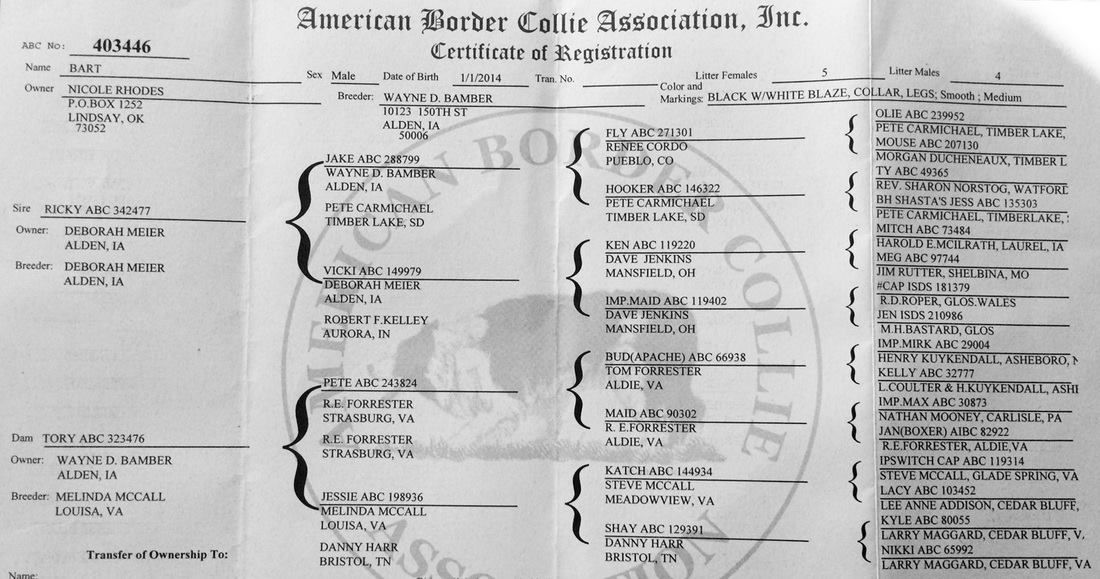This paper tells us that Wayne and Deb owned Jake and Vicki, those two were bred together to produce Ricky. So we would say that Ricky is of Wayne and Deb's breeding. We would not say he is their line, as while they selected Ricky's parents, neither of the crosses that produced Jake and Vicki were of their selection. Then Wayne and Deb crossed Ricky and Tory to produce Bart. Bart is of their breeding but at this point we might also say he is the first generation of their bloodline. There has been several generations of selection for what a particular breeder is looking for to produce him. It may be generations more to set a truly consistent type.
To get an accurate understanding of the dogs behind Bart and of what bloodlines or selection criteria may have been used we need a different source of information. To look farther back I often refer to The International Border Collie Association's online database. The information in it isn't always one hundred percent accurate as it is hand entered by a person using many different sources of information but it can be useful none the less. This database tells us not only the owner but the breeder of each dog (when the information is available) and sometimes his birth date and color.
If we look up Bart's sire, Ricky (click here to view), we very quickly can determine that his sire Jake would be considered to be from Pete Carmichael's bloodline. We can see that he was involved in at least four generations and maybe more if we look back further. Looking at Ricky's dam Vicky's side of the pedigree we see no clear cut bloodline close up. We may say her grandmother Meg appears to be Nyle Sealine's bloodline, and that the Kuykendalls were involved in the grandsire's side (I don't know the different Kuykendalls well enough to say they were working together toward a particular selection as there is more than one Kuykendall on the page) and there is some line breeding that has been done on both sides of her pedigree to various dogs but Vicky herself is not the product of a particular breeder's bloodline.
If we look up Bart's dam, Tory (click here to view), we can see that her sire Pete is Tom Forrester's bloodline. Tory herself, and her dam's side, is a little more complicated. We see the name McCall come up in several different generations but looking at this we might not necessarily call this their bloodline. Tory herself was bred by the McCalls but if we look at her mother Jessie we see that her breeder was someone else. Jessie's sire however was owned by the McCalls. Jessie is possibly a stud fee puppy (a puppy given to the owner of the stud dog in lieu of money) and not of any kind of specific selection of the McCalls. Jessie's sire Katch is possibly also a stud fee puppy as we see his sire was owned by the McCalls but not his dam. It is possible that the McCalls worked with these other breeders to select for these dogs but with the information we have we would conclude that Tory is their breeding but not their line.
ESTABLISHING A LINE:
There are people who have raised many generations of dogs but have never created a recognizable line: they were just breeding dogs, not selecting type! It takes careful consideration and honesty with oneself to recognize the various traits in a dog and bitch and to be able to consistently select for those things out of the resulting puppies. It takes many generations, a lot of pups, some successes, a whole lot of failures, and likely some inbreeding to create a recognizable type. It's made more difficult that when selecting for working traits one must wait until a pup is old enough to see what he is than if one were selecting for physical traits. Few people have the time and resources to dedicate. What winds up happening is that most breeders do not have the goal of producing a true line of dogs. They are just happy to raise some usable dogs.
Some things to think about if you hope to create a line of dogs:

